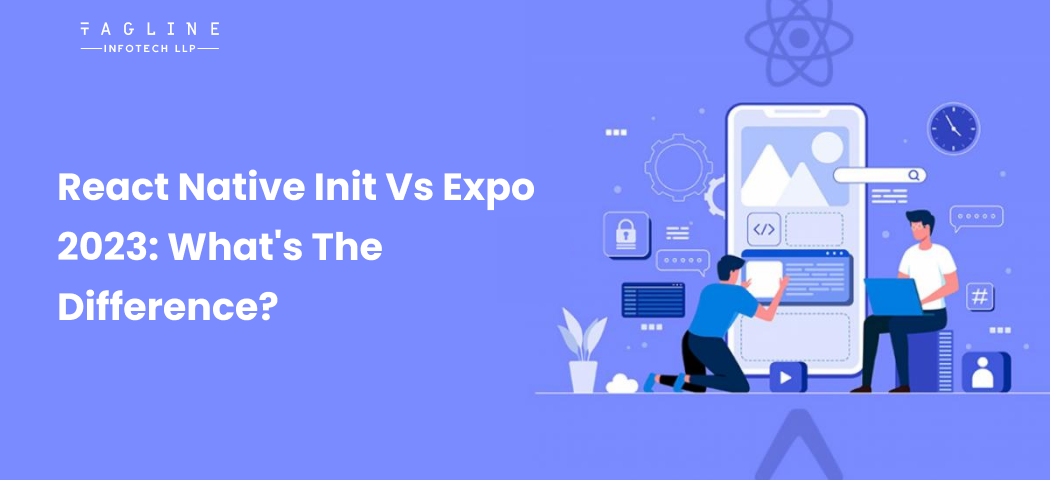React Native Init vs Expo 2023: What’s the Difference?

Introduction To Docker: A Beginner’s Guide
2nd November 2023
Django 5 Release
6th November 2023Introduction
There are two popular methods for creating a React Native app: the Expo CLI and React Native. If you’re looking to create a cross-platform app, you might be torn between Expo vs React Native and let us derive to a conclusion by taking a look at pros and cons of React Native vs Expo.
So, which one is preferable for app development? Let’s compare React Native Init vs Expo and see which one is better for your project.
What is React Native Init?
React Native has grown in popularity as a framework for creating cross-platform JavaScript apps. The ability to create cross-platform apps is its main advantage. They enable a much better UI than the current hybrid options on the market, bringing it closer to that of native apps. Native platform UI is rendered by React primitives. It means that your app will make use of the same native platform APIs as other apps. To get started, you’ll need Xcode or Android Studio.
What is Expo?
Expo is a React Native app development framework. It is a collection of React Native-specific tools and services. It will make it easier for you to start building React Native apps. It provides a set of tools to help you create and test your React Native app. Aside from that, Expo offers a more robust and convenient development workflow that is flexible.
The “Cross-Platform Mobile Development” tools are Expo and React Native App.
Having trouble deciding between Expo and Init while customizing your app?
Our team of experienced developers can help you navigate this decision-making process to select the best option among Expo and Init to customize your React Native app.
Pros and Cons of React Native
In this league of Expo vs React Native, the primary benefit of using React Native is the ability to share code between iOS and Android. Instead, you must create and maintain two completely separate codebases. Furthermore, you can reuse parts of your web app multiple times.
Flutter vs React Native difference can help you to decide which one is a better option. There are only a few situations where React Native CLI is the best option: working prototypes; apps with streamlined UI; basic cross-platform apps; apps without heavy use of native APIs; apps with complex User Interface; building utilities such as battery monitors; apps built specifically for a single OS; apps with few animations.
Pros of React Native:
- Native modules written in Java/Objective-C can be included.
- Creating .apk and.ipa files is much simpler than with Expo.
- Pre-built components and reusable code.
- The UI has been simplified.
- Support for third-party plugins.
- Architecture that is modular.
React Native has made a significant impact on mobile application development, but it has some drawbacks. Airbnb and Udacity recently shared their React Native experiences. They have concluded that this platform has numerous advantages. However, it cannot be used to create any type of mobile app.
Cons of React Native CLI:
- To run the projects, you’ll need Android Studio and XCode.
- You can’t create an iOS app without a Mac.
- It is not necessary to connect the device via USB for testing purposes.
- In XCode, there is no need to manually import fonts.
- If you want to send your app to someone, you must send the entire.apk/.ipa file.
- You have to install and link with, for example, npm Push-Notifications, Asset Manager.
- Setting up a working project correctly is difficult and time-consuming.
- It necessitates a high level of customization.
- It necessitates a basic understanding of Android and iOS folder structure.
Pros and Cons of Expo CLI
Now, Iets start with the disadvantages or limitations of Expo, because they have quite a few. And if your app requires something specific, you must determine whether Expo supports it. So, you can see why you shouldn’t use Expo in the first place.
Cons of Expo CLI:
1. Limitations:
I would like to emphasise the most serious issue: you can’t use native modules. That is, a project where you can run a React Native link for, say, vector icons serving as a limitation.
2. Libraries
A popular React Native library is the vector icons library. They are ineligible for use if you:
1) Some of the iOS or Android projects must be changed;
2) Make contact with CocoaPods or a Gradle;
3) Produce some Swift or Kotlin code.
So, anywhere we need to link something, Expo CLI fails. Expo supports other libraries in addition to the Vector Icons library. Expo creates a version of many libraries that you can use in your apps. Expo, therefore, cannot be used if you require specific Native module libraries or native modules.
3. Some iOS and Android APIs are not available
When talking about Expo vs React Native, another thing to keep in mind is that some of the device’s APIs are not supported. That’s also significant: no Bluetooth, no Web RTC. However, many features are currently in development, so it’s a good way to check a list of feature requests.
In any case, it’s a big deal. Expo should not be used if any of those things are required. The main thing to remember if none of these things are important to you on your project. And, if you don’t require native modules, Expo is a very good option that is highly recommended.
Pros of Expo CLI:
To know more about React Native vs Expo, let us look into the Pros of Expo CLI
1. No need to link and lots of libraries
Expo has created a library for you, which you can easily integrate. I agree with all of the XP libraries, and they are very fast and easy to integrate, which is a huge plus. Another thing to keep in mind is that there are numerous JavaScript libraries available for use with Expo.
2. Better development experience
The packager performs significantly better with Expo. Another cool feature is that you don’t have to plug your phone into your computer to use it. It can run the app you’re developing over Wi-Fi and sync between phones, which is fantastic. So you can be typing away on your computer, and as you make changes, other people’s phones update as well.
3. Easier to upgrade to new versions
The next benefit is that upgrading is much easier. The steps to upgrade to a new version are detailed in the upgrading documentation. It doesn’t take long to complete. So this is how upgrading an Expo looks.
4. Easier to deploy to Apple/Google Store
Next, it was much easier to get things into the Apple/Google Play app stores. It manages your keys, signing credentials, and certificates. It makes things easier.
5. Mobile UI
Barcode scanning makes it much easier to view on both Android and iPhone. It is also more convenient to view using online iPhone and Android simulators.
6. Over the air updates
Then there were massive out-of-the-box updates, which meant you had to resubmit it to the Apple or Google stores. It is not a big deal for Google; typically, it takes around two hours and your app is available to the public. But Apple has a very slow review process. The time it takes to update can be very long. So your app updates itself over-the-air, and it happens when the user opens the app.
7. Easier to set up deep linking
Also, it is very easy to set up different things at Expo. To set up a deep linking, It is surprising how simple it is to set up with that and React Navigation.
8. Expo SDK is available
Expo SDK is included with Expo apps. And it unlocks a slew of new features for your benefit. You can use BarcodeScanner, MapView, ImagePicker, and many other tools.
9. .apk and .ipa files
Expo creates an IPA file for iOS and an APK file for Android.
10· Ejecting
Finally, it is important to note that you can eject at any time. It’s comforting to know that you are not trapped and that you have other options. If you’re using Expo and realise you need a library outside of Expo, you can eject. This feature unpacks all of the Native code into iOs and Android folders. It also divides the App.js file into App.js and index.js.
similar blog Click
for more information Contact XpertLab





